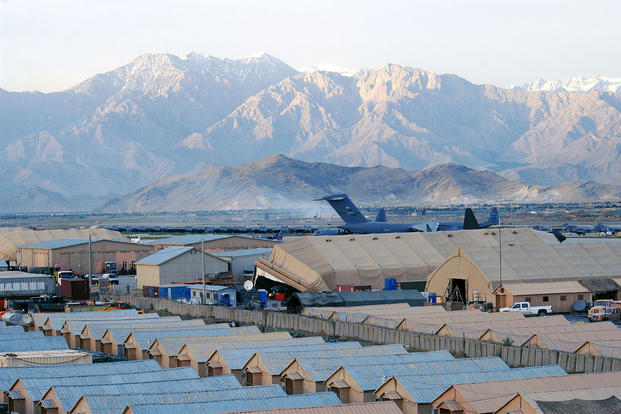The Pentagon is pushing to keep Bagram Airfield in Afghanistan open beyond 2017, defense officials confirmed to Fox News -- an appeal that comes as the Taliban gain ground in the country.
The proposal comes on top of President Obama revising his troop withdrawal timetable, agreeing in October to keep a 9,800-troop force through most of 2016 and then draw down to 5,500 -- despite originally vowing to leave a mere U.S. embassy presence in Kabul.
The status of the Bagram base, a vital center of operations located 30 miles north of Kabul, could well be the next front in the Pentagon's efforts to keep options open for the long-term U.S. presence in Afghanistan.
"If you don't leave a sizable force inside Afghanistan, the whole place will go to hell," one U.S. official said.
Taliban gains throughout the year have stirred concerns on Capitol Hill, and in Kabul, about the administration's end-game for the war -- which earlier prompted Obama to revise his withdrawal timetable.
While defense officials would like to see a sizable force remain long into the future, one source suggested that capability is more critical.
"As long as the capability is there, we are less concerned about the number [of U.S. forces]," another official said.
This is where Bagram comes in.
The New York Times first reported Monday that the White House is considering a Pentagon proposal to keep open for years at least one U.S. military base – which, sources tell Fox News, is Bagram.
Officials consider the base too valuable to close for fear of continued destabilization in Afghanistan and beyond. Special operations forces have carved out a section of the base to house their assault force and helicopters for missions throughout the region. Air Force F-16s also are based at Bagram and conduct airstrikes against the Taliban and other jihadist groups.
The U.S. Air Force conducted over 4,000 sorties, resulting in 916 weapons being dropped on enemy positions, so far this year.
The activity alone speaks to how fluid the situation in Afghanistan remains. On Oct. 7, U.S. special operations forces, partnering with Afghan forces, launched an attack on a sprawling Al Qaeda training camp in southern Afghanistan's Kandahar Province.
The raid killed up to 180 Taliban and Al Qaeda militants, Fox News is told, signaling increased U.S. special operations involvement in Afghanistan.
The U.S. military occupies two other bases in Jalalabad and Kandahar where drones can be launched as well. These bases are important for regional operations; the daring Navy SEAL raid to kill Usama bin Laden in 2011 was launched from Jalalabad. Without the Afghan base, the raid would have been considerably more difficult, according to officials.
As the administration weighs its options, the military is warning there may be no winter lull in the fighting. A Pentagon report released earlier this month said that high-profile attacks in Kabul increased by 27 percent in the past year.
The report included a poll indicating that fewer Afghans feel safe in their country. "Only 28 percent of Afghans say that security in their local area is good compared to 35 percent during the same time period in 2014 and 45 percent in 2013," it said.
Thousands of Afghan military soldiers have been killed in the past year; Afghan security forces suffered 27 percent more casualties in 2015, according to the report. In addition to gains by the Taliban throughout Afghanistan, an Islamic State offshoot has gained a foothold in Nangarhar Province in the east and is competing with the Taliban for influence.
After watching the Taliban make gains amid the questionable performance of the Afghan military and police force, officials in Washington do not want to see the country fall apart -- concerns that are driving the push to make the U.S. military presence in Afghanistan a long-term one.
In another sign of increasing volatility, six U.S. Air Force airmen were killed in an attack near Bagram Airfield last week.
According to the Washington Post, the Taliban now control or at least have a sizable presence in roughly 30 percent of Afghanistan, the most since 2001.




























